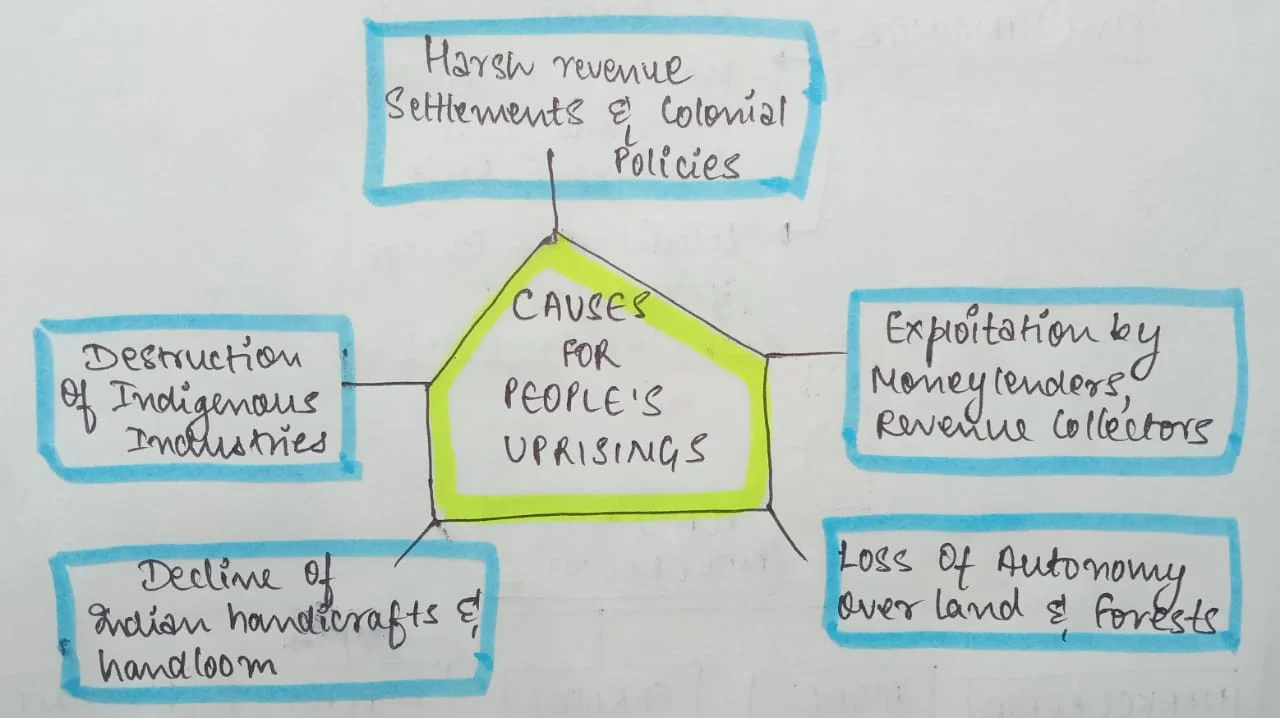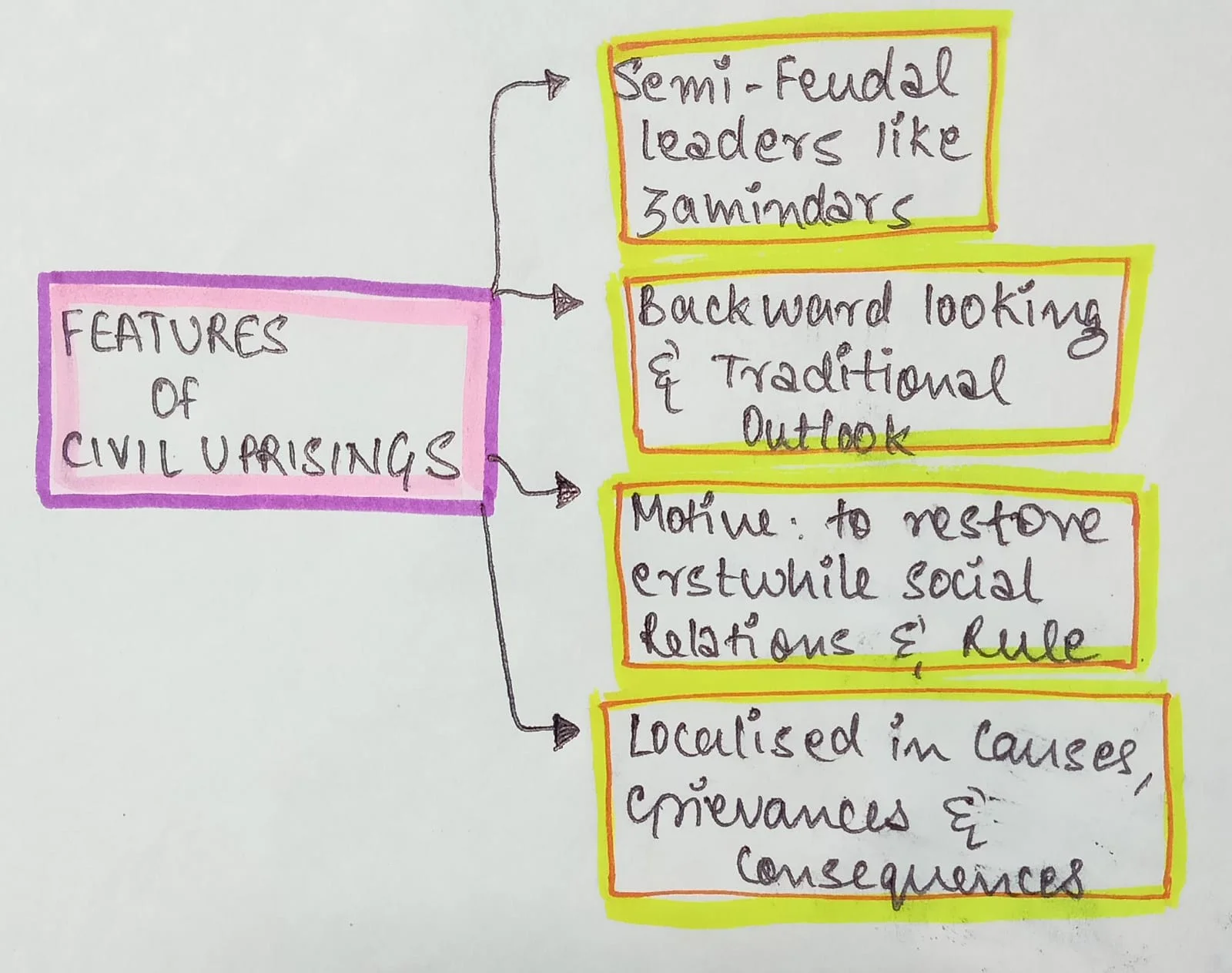The British acquisition of power in India unfolded gradually, marked by incremental conquests and subsequent efforts to control the economy and society, sparking dissatisfaction and opposition. Indian resistance against British rule encompassed diverse societal groups—peasants, artisans, tribals, ruling classes, military personnel, and religious leaders—who joined forces to protect their interests. According to historian Bipan Chandra, resistance took three main forms: civil rebellions, tribal uprisings, and peasant movements. Military revolts by Indians in the Company’s forces added depth to this historical period.
Factors that Led to People’s Uprisings #
British Policies: Colonial policies imposed harsh land revenue settlements, introduced new taxes, and forcibly evicted peasants from their lands. This also included encroachments on tribal territories.

- Rural Exploitation: Rural society faced exploitation, exacerbated by the rise of intermediary revenue collectors, tenants, and moneylenders.
- Industry and Agriculture: The destruction of indigenous industries prompted a shift of workers from industry to agriculture, intensifying the pressure on land and the agricultural sector.
- British Encroachment in Tribal Regions: The expansion of revenue administration into tribal lands resulted in the loss of tribal communities’ control over agricultural and forested areas.
- Unfair Trade Practices: British promotion of their manufactured goods, coupled with heavy duties on Indian industries, particularly export duties, led to the decline of Indian handloom and handicraft industries.
Enroll now for UPSC Online Course
Civil Uprisings
- Civil Rebellions in Early British India: The first 100 years of British rule in India were marked by a series of civil rebellions. Here, the term ‘civil’ refers to uprisings that are not related to military or defence matters.
| Poligars: in South India, holders of territory or palayam, consisting of a few villages granted to them by the rulers—mainly the Nayakas—in return for military service and tribute. |
- Leadership and Support Base: These uprisings were led by various groups, including deposed rajas, nawabs, and their descendants, uprooted zamindars, landlords, and poligars in South India, as well as ex-retainers and officials of conquered Indian states.
- These uprisings garnered mass support from oppressed peasants, jobless artisans, and disbanded soldiers.
- However, at the core of these movements were the once-powerful ruling classes.
- Urban movements in Benaras (1810), Surat (1814), and Bareilly (1816) saw collaboration between different strata against British rule. Before colonial rule, protests against rulers were common, but colonial authorities’ focus on revenue extraction and a biased legal system intensified grievances, leading to armed resistance.
- Tribal communities faced encroachment, escalating their resistance due to increased violence in their autonomous territories.
Causes of Civil Uprisings
- Economic and Administrative Exploitation Under Company Rule: Under Company rule, significant economic, administrative, and land revenue system changes were detrimental to the people.
- Displacement and Resentment Among Zamindars and Poligars: Many Zamindars and Poligars, who lost control over their land and revenues, harboured personal grievances against the new rulers.
- Traditional zamindars and poligars felt slighted by government officials and a new class of merchants and money-lenders who outranked them.
- Decline of Indian Handicrafts and Artisan Pauperization: Indian handicraft industries suffered due to free trade policies and discriminatory tariffs imposed by the British, leading to the pauperization of millions of artisans.
- Legal and Administrative Corruption Favors the Elite: The new legal system empowered the rich and led to the oppression of the poor.
- Corruption at the lower levels of the police, judiciary, and administration further aggravated the situation.
- Resentment Among the Priesthood Due to Social Upheaval: The priestly classes incited resentment and rebellion against foreign rule because they depended on the traditional elite.
- The fall of zamindars and feudal lords directly impacted the priestly class.
- Alienation and Cultural Disdain by the British Rulers: The foreign nature of the British rulers, always perceived as outsiders, and their disdainful treatment of the native people wounded the pride of the indigenous population.
General Features of Civil Uprisings
- Local in Character: These rebellions were local, driven by specific grievances and conditions. While they were widespread in totality, they were isolated from each other in time and space.

- Leaders Rooted in the Cause: The leaders of these rebellions were socially, economically, and politically backward-looking, adhering to traditional forms and content.
- Their objective was to restore earlier forms of rule and social relations.
- Most of these uprisings were an attempt to restore old status in terms of authority and social relations.
- Ruthless Suppression: The British pacified rebel areas one by one, offering concessions to less defiant rebel chiefs and zamindars. Those who resisted were often brutally suppressed.
- The suppression of these civil rebellions played a significant role in preventing the spread of the Revolt of 1857 to South India and most of Eastern and Western India.
- Importance: These civil uprisings established strong local traditions of resistance to British rule, which would later inspire the nationalist struggle for freedom.
Enroll now for UPSC Online Course
| Must Read | |
| Current Affairs | Editorial Analysis |
| Upsc Notes | Upsc Blogs |
| NCERT Notes | Free Main Answer Writing |
Conclusion #
Indian resistance against British rule was marked by diverse uprisings driven by economic exploitation, administrative abuses, and cultural disdain. From civil rebellions to tribal uprisings, these movements reflected deep-seated grievances and a desire to restore traditional order. Despite brutal suppression, these early resistances laid a crucial foundation for the broader nationalist struggle for independence.
Sign up for the PWOnlyIAS Online Course by Physics Wallah and start your journey to IAS success today!
| Related Articles | |
| Tribal Communities in India | British Policy in India |
| INDIAN ECONOMY NOTES | Agriculture |

 GS Foundation
GS Foundation Crash Course
Crash Course Combo
Combo Optional Courses
Optional Courses Degree Program
Degree Program












